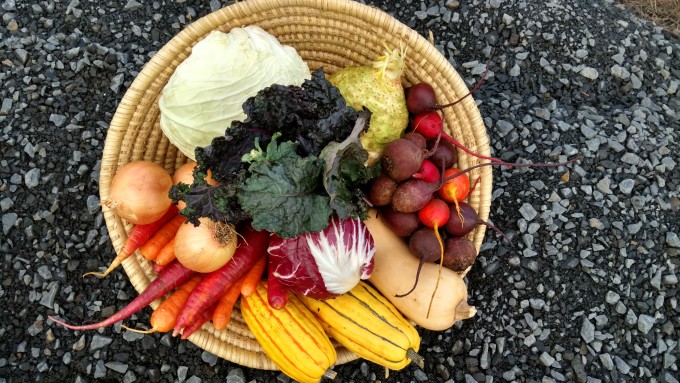In Your Share This Week
- Beets, baby mix
- Cabbage
- Carrot, mix
- Celeriac
- Kale, mix
- Onions, Cortland
- Radicchio
- Winter Squash, Butternut & Delicata
Crop Notes
Beet, baby mix: We gave you a bag of mixed baby beets that includes red, gold, and Chioggia varieties. The mix is primarily red beets, and the size is great for roasting in halves or boiling whole.
Cabbage: These lovely green cabbages are a type known as a ‘semi-savoy’, which means they have a slightly more crinkled in texture than what you may typically think of when you envision green cabbage. It also a flatter, squat shape, but it still cooks and tastes like a regular green cabbage. We love this type of cabbage because it holds so well in the field through all types of weather conditions, including ice, frost, rain, wind, and heat.
Carrot, mix: This week we blended our standard orange carrots with a purple-skinned variety called ‘Dragon’. Both are tasty either raw or cooked but the purple skins on the Dragon fade when cooked…but another really cool thing happens- the interior flesh turns a darker, richer shade of orange and it looks (and kind of tastes) like a sweet potato. At least that’s what we thought…try it out and see what you think!
Celeriac: Its our very first celeriac of the winter season! You may also know this crop as ‘celery root’ or ‘knob celery’- its a variety of celery that has been cultivated and bred over time in order to produce a large, bulbous root rather than the fleshy stems and leaves we all recognize as celery. This is a great staple for winter soups, stocks, stews, casseroles, and gratins. Celeriac also has tremendous storage life and can last over 6 months in storage so long as the humidity is sufficient, which is why it was probably more common in America several generations ago when putting up food for the winter was a more widespread activity rather than trips to the grocery store. You will want to peel the celeriac before using it; to do that, start by trimming off the top and most of the root mass on the bottom. Now that the bottom is flat, set that on the counter and trim along the sides with your knife. These peelings are indispensable additions to the stock pot!
Kale, mix: Viva diversity!!! This bag of kale mix features most of the kale varieties that we grow. We skipped washing the kale in order to avoid cracking, bruising, and the like- so we recommend giving it a rinse before eating just in case it has any soil splattered on the undersides from the rain. You’ll find red, purple, green, crinkled, smooth, wavy, ruffled…you can rough chop it all together for cooking, or if you want to have a kale taste-off you can try each type on its own and see how it cooks and tastes. I’ve used the super ruffled green (a winterbor kale) in the past for raw ‘massaged’ kale salad and I hear its good for kale chips too. If you’re wondering what exactly massaged kale salad is, pay a visit to this website for a base recipe and some excellent variations.

